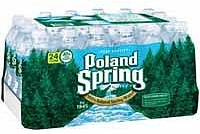A few weeks ago I took my daughter and two of her friends to see Bruno Mars in concert. There’s something about hearing a performer live that’s really amazing, and I’m happy to take them to more concerts in the future. And the Big Guy(tm) was there for me with a parking space. $34 to park in the lot at TD Bank Garden (formerly, The Boston Garden) but a spot was waiting for me right down the street, $2 for a meter. I like that.  See this case of water? $4 this week at my supermarket. 6 bottles for $1. At the show, on the way into the building, there was an icecream stand, and they happened to sell water, $2, and I bought one for my daughter. Up the stairs, 50 feet later was the entrance to the show. “Can’t bring in outside water.” $2 went right into the trash. After 45 minutes of screaming, I get a request, “dad, can you buy me a water?” No problem. Then I found out why the thugs on the way in had me toss our $2 bottle. The concession stand inside the arena charged $5 for the same sized bottle. $5? It’s amazing to me how a gas station or hardware store can be accused of price gouging when they raise the price just bit on something when the weather turns bad. Here, the arena has a captive audience and charges 30X the price I’d pay a few streets away at a supermarket, and 5X the price that would still make them money but not make me feel ripped off. Before you ask – yes, I bring my own water into the movie theater, no they don’t stop me.
See this case of water? $4 this week at my supermarket. 6 bottles for $1. At the show, on the way into the building, there was an icecream stand, and they happened to sell water, $2, and I bought one for my daughter. Up the stairs, 50 feet later was the entrance to the show. “Can’t bring in outside water.” $2 went right into the trash. After 45 minutes of screaming, I get a request, “dad, can you buy me a water?” No problem. Then I found out why the thugs on the way in had me toss our $2 bottle. The concession stand inside the arena charged $5 for the same sized bottle. $5? It’s amazing to me how a gas station or hardware store can be accused of price gouging when they raise the price just bit on something when the weather turns bad. Here, the arena has a captive audience and charges 30X the price I’d pay a few streets away at a supermarket, and 5X the price that would still make them money but not make me feel ripped off. Before you ask – yes, I bring my own water into the movie theater, no they don’t stop me.
Frugal Friday Week 45
Next post: The return of an icon?
Previous post: How the Wrong IRA Investments Can Cost an Extra 44% in Tax

TD Bank Garden? I left Boston in 2004 and just now learned of this; apparently that name was created just then. These corporate names are getting grimmer by the decade. What’s next? The Clayton, Dubilier & Rice Public Entertainment Emporium?
And I’d rather drink my own urine than pay $5 for a small bottle of water. Let’s see them try to ban *that*. (Plus, all good people should refuse on principle to drink out of plastic bottled water. That whole trend is a horribly wrong-headed).
There are things I’d not buy for myself, but how do I say ‘no’ when I just bought 2 $8 beers for the other dad and me? And yes, $1 supermarket, $5 bar, so the beer was a ripoff too.
At a supermarket checkout, a scanner records the prices of the foods you buy. In order to protect consumers, the state of Michigan passed a “scanning law†that says something similar to the following: If there is a discrepancy between the price marked on the item and the price recorded by the scanner, the consumer is entitled to receive 10 times the difference between those prices; this amount given must be at least $1 and at most $5. Also, the consumer will be given the difference between the prices, in addition to the amount calculated above. For example: If the difference is 5c/, you should receive $1 (since 10 times the difference is only 50c/ and you are to receive at least $1), plus the difference of 5c/. Thus, the total you should receive is $1.00 $0.05 = $1.05, If the difference is 25c/, you should receive 10 times the difference in addition to the difference, giving(10)(0.25) 0.25 = $2.75. If the difference is 95c/, you should receive $5 (because 10(.95) = $9.50 is more than $5, the maximum penalty), plus 95c/, giving 5 0.95 = $5.95. (a) What is the lowest possible refund? (b) Suppose x is the difference between the price scanned and the price marked on the item, and y is the amount refunded to the customer. Write a formula for y in terms of x. (Hints: Look at the sample calculations.) (c) What would the difference between the price scanned and the price marked have to be in order to obtain a $9.00 refund? (d) Graph y as a function of x.
Wow, I like this, but pretty complex way to do the math. Thanks for writing. I wonder how many states have such laws.